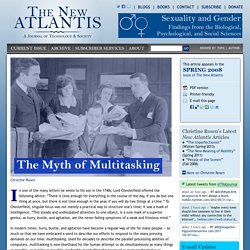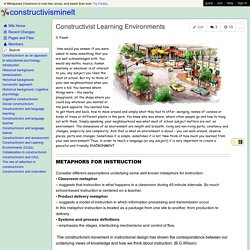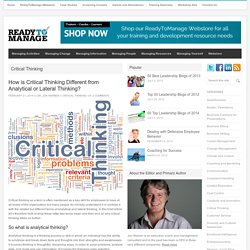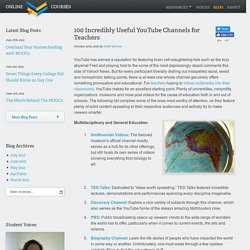

Multi-Tasking and it’s Effect on Concentration, Intelligence, and Reasoning. Recently there was an experiment conducted that studied two sets of people. One consisted of individuals who multi-tasked constantly, while the other group rarely engaged in multi-tasking. Both groups were comprised strictly of students attending Stanford University, so it can be assumed that all are of above average intelligence. In order to compare their methods of concentration and managing information, both groups took part in a number of cognitive exercises. When some type of interference surfaced during the test, the individuals who multi-tasked frequently had difficulty maintaining concentration. The poorer results produced by the people accustomed to multi-tasking was surprising, as it would be expected that their background and familiarity with performing multiple tasks simultaneously, would have meant that they were better equipped to handle such an exercise.
The Myth of Multitasking. Christine Rosen In one of the many letters he wrote to his son in the 1740s, Lord Chesterfield offered the following advice: “There is time enough for everything in the course of the day, if you do but one thing at once, but there is not time enough in the year, if you will do two things at a time.”

To Chesterfield, singular focus was not merely a practical way to structure one’s time; it was a mark of intelligence. “This steady and undissipated attention to one object, is a sure mark of a superior genius; as hurry, bustle, and agitation, are the never-failing symptoms of a weak and frivolous mind.”
In modern times, hurry, bustle, and agitation have become a regular way of life for many people — so much so that we have embraced a word to describe our efforts to respond to the many pressing demands on our time: multitasking. Questioning Techniques. SO, What’s THE CHANGE For Teachers In 21st Century Education!? – EDU: Digital CitiZENship, CyberSecurity, eSkills, Modern EDU by Gust MEES. This is a general overview only to explain in simple words: I get asked very often and get also a lot of discussions with people and also teachers about what’s THE real CHANGE in 21st Century Education and especially for teachers, even that MOST people tell me that “THE CHANGE” is very difficult to understand!

BUT it’s actually very easy to understand, BUT it needs to get accepted from the teachers! This is my point of view, let me explain, please:. What really changed for teachers is the way they will teach the students, THEY are NOT anymore “THE BOSS” in the classroom, ===> THEY are NOW a coach! <=== Someone who is guiding the students (learners) in THEIR way of learning and showing THEM how to learn and to deal with the BIG DATA on the Internet! It’s NOW ===> Us and THEM <===, WE try to work as a team for getting BEST results, it is NOW learner-centered! Image source: Prepare Learners for the Global Workforce THIS ALL needs a serious up-to-date of Professional Development!
Information Literacy. ‘Our Technology Is Our Ideology’: George Siemens on the Future of Digital Learning. What does it mean to be human in a digital age?

Some people researching education technology might not spend their days wondering how their work fits into this existential question—but George Siemens isn’t "some people. " “Maybe my mama hugged me extra when I was a baby.” That’s his explanation for how he thinks about the role of education in the 21st century. A researcher, theorist, educator, Siemens is the digital learning guy. He’s credited with co-teaching the first MOOC in 2008, introduced the theory of “connectivism”—the idea that knowledge is distributed across digital networks—and spearheaded research projects about the role of data and analytics in education. SEFE 680 paper. Constructivisminelt - Constructivist Learning Environments. © Paweł How would you answer if you were asked to name something that you are well acknowledged with.

You would say maths, musics, human anatomy or whatever is of interest to you, any subject you liked the most at school. But try to think of your own neighbourhood when you were a kid. You learned where things were – the nearby playground, all the shops where you could buy whatever you wanted or the park opposite. Learning Resources. How is Critical Thinking Different from Analytical or Lateral Thinking? Critical thinking as a term is often mentioned as a key skill for employees to have at all levels of the organization but many people do not fully understand it or confuse it with the related but different terms of analytical and lateral thinking.

In this brief article let’s therefore look at what these latter two terms mean and then end on why critical thinking takes us further. Learning Styles. Educational Technology and Mobile Learning: The 8 Elements of The Critical Thinking Process. April 3, 2014 You ask any teacher about the skills they want their students to develop and critical thinking will be among the first cited skills.

So what is critical thinking all about ? Critical thinking is a cognitive process that requires disruptive patterns of thinking, ones that question the status quo of propositions and leads to the creation of alternative lines of reasoning. 100 Incredibly Useful YouTube Channels for Teachers. YouTube has earned a reputation for featuring brain cell-slaughtering fare such as the truly abysmal Fred and playing host to the some of the most depressingly stupid comments this side of Yahoo!

News. 21st Century Essential Skills Resources. Search ERIC Page. Note: Many web browsers do not support telnet or TN3270. How to order documents ERIC references with an ED number are from ERIC's Resources in Education database and are typically research papers and other monographs. Almost all of these documents are available on microfiche at the ERIC Resource Collections located in over 1000 academic libraries and centers worldwide. Neuroscience. Education/learning. EdTech Blogs. Educational Blogs. Teach study skills. Game-Based Learning & Simulations. Collaborative Community. Conscious Learning. Mobile Learning Implementation Resources. A Prezi Guide to an Effective School - Learning together. 21st Century Learning.
Gifted. Great educators. 21st century learning. The Inside-Out School: A 21st Century Learning Model. The Inside-Out School: A 21st Century Learning Model by Terry Heick As a follow-up to our 9 Characteristics of 21st Century Learning we developed in 2009, we have developed an updated framework, The Inside-Out Learning Model.

The goal of the model is simple enough–not pure academic proficiency, but instead authentic self-knowledge, diverse local and global interdependence, adaptive critical thinking, and adaptive media literacy. By design this model emphasizes the role of play, diverse digital and physical media, and a designed interdependence between communities and schools.